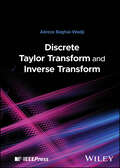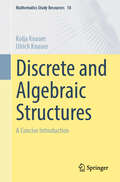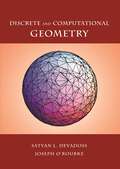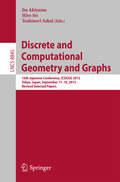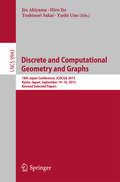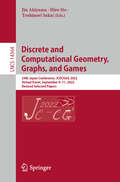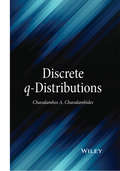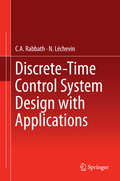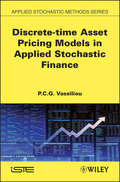- Table View
- List View
Discrete Taylor Transform and Inverse Transform
by Alireza Baghai-WadjiRevolutionize the calculation of mixed derivatives with this groundbreaking text Transform and inverse transform techniques, such as the Fourier transform and the Laplace transform, enable scientists and engineers to conduct research and design in transformed domains where the work is simpler, after which the results can be converted back into the real domain where they can be applied or actualized. This latter stage in the process, the inverse transform, ordinarily poses significant challenges. New transform/inverse transform techniques carry extraordinary potential to produce revolutionary new science and engineering solutions. Discrete Taylor Transform and Inverse Transform presents the groundbreaking discovery of a new transform technique. Placing a novel emphasis on the “position variable” and “derivative operator” as main actors, the Discrete Taylor Transform and Inverse Transform (D-TTIT) will facilitate the calculation of mixed derivatives of multivariate functions to any desired order. The result promises to create new applications not only in its allied fields of quantum physics and quantum engineering, but potentially much more widely. Readers will also find: Discussion of possible applications in electrical engineering, acoustics, photonics, and many more Analysis of functions depending on one, two, or three independent variables Tools for theoreticians and practitioners to design their own algorithms for solving specific boundary-value problems Discrete Taylor Transform and Inverse Transform is ideal for any scientific or engineering professional looking to understand a cutting-edge research and design tool.
Discrete Time Branching Processes in Random Environment
by Götz Kersting Vladimir VatutinBranching processes are stochastic processes which represent the reproduction of particles, such as individuals within a population, and thereby model demographic stochasticity. In branching processes in random environment (BPREs), additional environmental stochasticity is incorporated, meaning that the conditions of reproduction may vary in a random fashion from one generation to the next. This book offers an introduction to the basics of BPREs and then presents the cases of critical and subcritical processes in detail, the latter dividing into weakly, intermediate, and strongly subcritical regimes.
Discrete Variational Derivative Method: A Structure-Preserving Numerical Method for Partial Differential Equations (Chapman & Hall/CRC Numerical Analysis and Scientific Computing Series)
by Daisuke Furihata Takayasu MatsuoNonlinear Partial Differential Equations (PDEs) have become increasingly important in the description of physical phenomena. Unlike Ordinary Differential Equations, PDEs can be used to effectively model multidimensional systems. The methods put forward in Discrete Variational Derivative Method concentrate on a new class of "structure-preserving num
Discrete Wavelet Transformations: An Elementary Approach with Applications
by Patrick J. Van FleetUpdated and Expanded Textbook Offers Accessible and Applications-First Introduction to Wavelet Theory for Students and Professionals The new edition of Discrete Wavelet Transformations continues to guide readers through the abstract concepts of wavelet theory by using Dr. Van Fleet’s highly practical, application-based approach, which reflects how mathematicians construct solutions to challenges outside the classroom. By introducing the Haar, orthogonal, and biorthogonal filters without the use of Fourier series, Van Fleet allows his audience to connect concepts directly to real-world applications at an earlier point than other publications in the field. Leveraging extensive graphical displays, this self-contained volume integrates concepts from calculus and linear algebra into the constructions of wavelet transformations and their applications, including data compression, edge detection in images and denoising of signals. Conceptual understanding is reinforced with over 500 detailed exercises and 24 computer labs. The second edition discusses new applications including image segmentation, pansharpening, and the FBI fingerprint compression specification. Other notable features include: Two new chapters covering wavelet packets and the lifting method A reorganization of the presentation so that basic filters can be constructed without the use of Fourier techniques A new comprehensive chapter that explains filter derivation using Fourier techniques Over 120 examples of which 91 are “live examples,” which allow the reader to quickly reproduce these examples in Mathematica or MATLAB and deepen conceptual mastery An overview of digital image basics, equipping readers with the tools they need to understand the image processing applications presented A complete rewrite of the DiscreteWavelets package called WaveletWare for use with Mathematica and MATLAB A website, www.stthomas.edu/wavelets, featuring material containing the WaveletWare package, live examples, and computer labs in addition to companion material for teaching a course using the book Comprehensive and grounded, this book and its online components provide an excellent foundation for developing undergraduate courses as well as a valuable resource for mathematicians, signal process engineers, and other professionals seeking to understand the practical applications of discrete wavelet transformations in solving real-world challenges.
Discrete Weak KAM Theory: An Introduction through Examples and its Applications to Twist Maps (Lecture Notes in Mathematics #2377)
by Maxime ZavidoviqueThe aim of this book is to present a self-contained account of discrete weak KAM theory. Putting aside its intrinsic elegance, this theory also provides a toy model for classical weak KAM theory, where many technical difficulties disappear, but where the central ideas and results persist. It therefore serves as a good introduction to (continuous) weak KAM theory. The first three chapters give a general exposition of the general abstract theory, concluding with a discussion of the relations between the results proved in the discrete setting and the analogous theorems of classical weak KAM theory. Several examples are studied and some key differences between the discrete and classical theory are highlighted. The final chapter is devoted to the historical problem of conservative twist maps of the annulus.
Discrete and Algebraic Structures: A Concise Introduction (Mathematics Study Resources #18)
by Ulrich Knauer Kolja KnauerThis textbook presents the topics typically covered in a standard course on discrete structures. It is aimed at students of computer science and mathematics (teaching degree and Bachelor's/Master's) and is designed to accompany lectures, for self-study, and for exam preparation. Through explanatory introductions to definitions, numerous examples, counterexamples, diagrams, cross-references, and outlooks, the authors manage to present the wide range of topics concisely and comprehensibly. Numerous exercises facilitate the deepening of the material. Due to its compact presentation of all important discrete and algebraic structures and its extensive index, the book also serves as a reference for mathematicians, computer scientists, and natural scientists. Contents: From propositional and predicate logic to sets and combinatorics, numbers, relations and mappings, graphs, to the rich spectrum of algebraic structures, and a brief introduction to category theory. Additional chapters include rings and modules as well as matroids. This book is a translation of the second German edition. The translation was done with the help of artificial intelligence. A subsequent human revision was done primarily in terms of content, so the book may read stylistically differently from a conventional translation.
Discrete and Computational Geometry
by Joseph O'Rourke Satyan L. DevadossAn essential introduction to discrete and computational geometryDiscrete geometry is a relatively new development in pure mathematics, while computational geometry is an emerging area in applications-driven computer science. Their intermingling has yielded exciting advances in recent years, yet what has been lacking until now is an undergraduate textbook that bridges the gap between the two. Discrete and Computational Geometry offers a comprehensive yet accessible introduction to this cutting-edge frontier of mathematics and computer science.This book covers traditional topics such as convex hulls, triangulations, and Voronoi diagrams, as well as more recent subjects like pseudotriangulations, curve reconstruction, and locked chains. It also touches on more advanced material, including Dehn invariants, associahedra, quasigeodesics, Morse theory, and the recent resolution of the Poincaré conjecture. Connections to real-world applications are made throughout, and algorithms are presented independently of any programming language. This richly illustrated textbook also features numerous exercises and unsolved problems.The essential introduction to discrete and computational geometryCovers traditional topics as well as new and advanced materialFeatures numerous full-color illustrations, exercises, and unsolved problemsSuitable for sophomores in mathematics, computer science, engineering, or physicsRigorous but accessibleAn online solutions manual is available (for teachers only).
Discrete and Computational Geometry and Graphs
by Jin Akiyama Hiro Ito Toshinori SakaiThis book constitutes the thoroughly refereed post-conference proceedings of the 16th Japanese Conference on Discrete and computational Geometry and Graphs, JDCDGG 2013, held in Tokyo, Japan, in September 2013. The total of 16 papers included in this volume was carefully reviewed and selected from 58 submissions. The papers feature advances made in the field of computational geometry and focus on emerging technologies, new methodology and applications, graph theory and dynamics.
Discrete and Computational Geometry and Graphs
by Jin Akiyama Hiro Ito Toshinori Sakai Yushi UnoThis book constitutes the thoroughly refereed post-conference proceedings of the 18th Japanese Conference on Discrete and Computational Geometry and Graphs, JDCDGG 2015, held in Kyoto, Japan, in September 2015. The total of 25 papers included in this volume was carefully reviewed and selected from 64 submissions. The papers feature advances made in the field of computational geometry and focus on emerging technologies, new methodology and applications, graph theory and dynamics. This proceedings are dedicated to Naoki Katoh on the occasion of his retirement from Kyoto University.
Discrete and Computational Geometry and Graphs: 18th Japan Conference, JCDCGG 2015, Kyoto, Japan, September 14-16, 2015, Revised Selected Papers (Lecture Notes in Computer Science #9943)
by Jin Akiyama, Hiro Ito, Toshinori Sakai and Yushi UnoThis book constitutes the thoroughly refereed post-conference proceedings of the 18th Japanese Conference on Discrete and Computational Geometry and Graphs, JDCDGG 2015, held in Kyoto, Japan, in September 2015. The total of 25 papers included in this volume was carefully reviewed and selected from 64 submissions. The papers feature advances made in the field of computational geometry and focus on emerging technologies, new methodology and applications, graph theory and dynamics. This proceedings are dedicated to Naoki Katoh on the occasion of his retirement from Kyoto University.
Discrete and Computational Geometry, 2nd Edition
by Joseph O'Rourke Satyan L. DevadossThe essential introduction to discrete and computational geometry—now fully updated and expandedDiscrete and Computational Geometry bridges the theoretical world of discrete geometry with the applications-driven realm of computational geometry, offering a comprehensive yet accessible introduction to this cutting-edge frontier of mathematics and computer science. Beginning with polygons and ending with polyhedra, it explains how to capture the shape of data given by a set of points, from convex hulls and triangulations to Voronoi diagrams, geometric duality, chains, linkages, and alpha complexes. Connections to real-world applications are made throughout, and algorithms are presented independent of any programming language. Now fully updated and expanded, this richly illustrated textbook is an invaluable learning tool for students in mathematics, computer science, engineering, and physics.Now with new sections on duality and on computational topologyProject suggestions at the end of every chapterCovers traditional topics as well as new and advanced materialFeatures numerous full-color illustrations, exercises, and fully updated unsolved problemsUniquely designed for a one-semester classAccessible to college sophomores with minimal backgroundAlso suitable for more advanced studentsOnline solutions manual (available to instructors)
Discrete and Computational Geometry, Graphs, and Games: 24th Japanese Conference, JCDCGGG 2022, Virtual Event, September 9–11, 2022, Revised Selected Papers (Lecture Notes in Computer Science #14364)
by Jin Akiyama Hiro Ito Toshinori SakaiThis book, LNCS 14364, constitutes the refereed proceedings of the 24th Japanese Conference on Discrete and Computational Geometry and Graphs, JCDCGGG 2022, held virtually during September 9-11, 2022. The 22 full papers included in this volume were carefully reviewed and selected from 35 submissions. The papers feature advances made in the field of computational geometry and focus on emerging technologies, new methodology and applications, graph theory and dynamics.
Discrete and Continuous Fourier Transforms: Analysis, Applications and Fast Algorithms
by Eleanor ChuLong employed in electrical engineering, the discrete Fourier transform (DFT) is now applied in a range of fields through the use of digital computers and fast Fourier transform (FFT) algorithms. But to correctly interpret DFT results, it is essential to understand the core and tools of Fourier analysis. Discrete and Continuous Fourier Transform
Discrete and Continuous Models in the Theory of Networks (Operator Theory: Advances and Applications #281)
by Delio Mugnolo Fatihcan M. Atay Pavel B. KurasovThis book contains contributions from the participants of the research group hosted by the ZiF - Center for Interdisciplinary Research at the University of Bielefeld during the period 2013-2017 as well as from the conclusive conference organized at Bielefeld in December 2017. The contributions consist of original research papers: they mirror the scientific developments fostered by this research program or the state-of-the-art results presented during the conclusive conference.The volume covers current research in the areas of operator theory and dynamical systems on networks and their applications, indicating possible future directions. The book will be interesting to researchers focusing on the mathematical theory of networks; it is unique as, for the first time, continuous network models - a subject that has been blooming in the last twenty years - are studied alongside more classical and discrete ones. Thus, instead of two different worlds often growing independently without much intercommunication, a new path is set, breaking with the tradition. The fruitful and beneficial exchange of ideas and results of both communities is reflected in this book.
Discrete or Continuous?
by Amit HagarThe idea of infinity plays a crucial role in our understanding of the universe, with the infinite spacetime continuum perhaps the best-known example - but is spacetime really continuous? Throughout the history of science, many have felt that the continuum model is an unphysical idealization, and that spacetime should be thought of as 'quantized' at the smallest of scales. Combining novel conceptual analysis, a fresh historical perspective, and concrete physical examples, this unique book tells the story of the search for the fundamental unit of length in modern physics, from early classical electrodynamics to current approaches to quantum gravity. Novel philosophical theses, with direct implications for theoretical physics research, are presented and defended in an accessible format that avoids complex mathematics. Blending history, philosophy, and theoretical physics, this refreshing outlook on the nature of spacetime sheds light on one of the most thought-provoking topics in modern physics.
Discrete q-Distributions
by Charalambos A. CharalambidesA self-contained study of the various applications and developments of discrete distribution theory Written by a well-known researcher in the field, Discrete q-Distributions features an organized presentation of discrete q-distributions based on the stochastic model of a sequence of independent Bernoulli trials. In an effort to keep the book self-contained, the author covers all of the necessary basic q-sequences and q-functions. The book begins with an introduction of the notions of a q-power, a q-factorial, and a q-binomial coefficient and proceeds to discuss the basic q-combinatorics and q-hypergeometric series. Next, the book addresses discrete q-distributions with success probability at a trial varying geometrically, with rate q, either with the number of previous trials or with the number of previous successes. Further, the book examines two interesting stochastic models with success probability at any trial varying geometrically both with the number of trials and the number of successes and presents local and global limit theorems. Discrete q-Distributions also features: Discussions of the definitions and theorems that highlight key concepts and results Several worked examples that illustrate the applications of the presented theory Numerous exercises at varying levels of difficulty that consolidate the concepts and results as well as complement, extend, or generalize the results Detailed hints and answers to all the exercises in an appendix to help less-experienced readers gain a better understanding of the content An up-to-date bibliography that includes the latest trends and advances in the field and provides a collective source for further research An Instructor's Solutions Manual available on a companion website A unique reference for researchers and practitioners in statistics, mathematics, physics, engineering, and other applied sciences, Discrete q-Distributions is also an appropriate textbook for graduate-level courses in discrete statistical distributions, distribution theory, and combinatorics.
Discrete-Time Control System Design with Applications
by C. A. Rabbath N. LéchevinThis unique book provides a bridge between digital control theory and vehicle guidance and control practice. It presents practical techniques of digital redesign and direct discrete-time design suitable for a real-time implementation of controllers and guidance laws at multiple rates and with and computational techniques. The theory of digital control is given as theorems, lemmas, and propositions. The design of the digital guidance and control systems is illustrated by means of step-by-step procedures, algorithms, and case studies. The systems proposed are applied to realistic models of unmanned systems and missiles, and digital implementation.
Discrete-Time Sliding Mode Protocols for Discrete Multi-Agent System (Studies in Systems, Decision and Control #303)
by Axaykumar Mehta Keyurkumar PatelThis book presents few novel Discrete-time Sliding Mode (DSM) protocols for leader-following consensus of Discrete Multi-Agent Systems (DMASs). The protocols intend to achieve the consensus in finite time steps and also tackle the corresponding uncertainties. Based on the communication graph topology of multi-agent systems, the protocols are divided into two groups, namely (i) Fixed graph topology and (ii) Switching graph topology. The coverage begins with the design of Discrete-time Sliding Mode (DSM) protocols using Gao’s reaching law and power rate reaching law for the synchronization of linear DMASs by using the exchange of information between the agents and the leader to achieve a common goal. Then, in a subsequent chapter, analysis for no. of fixed-time steps required for the leader-following consensus is presented. The book also includes chapters on the design of Discrete-time Higher-order Sliding Mode (DHSM) protocols, Event-triggered DSM protocols for the leader-following consensus of DMASs. A chapter is also included on the design of DHSM protocols for leader-following consensus of heterogeneous DMASs.Special emphasis is given to the practical implementation of each proposed DSM protocol for achieving leader-following consensus of helicopter systems, flexible joint robotic arms, and rigid joint robotic arms. This book offers a ready reference guide for graduate students and researchers working in the areas of control, automation, and communication engineering, and in particular the cooperative control of multi-agent systems. It will also benefit professional engineers working to design and implement robust controllers for power systems, autonomous vehicles, military surveillance, smartgrids/microgrids, vehicle traffic management, robotic teams, and aerial robots.
Discrete-Time and Discrete-Space Dynamical Systems (Communications and Control Engineering)
by Lihua Xie Lijun Zhang Kuize ZhangDiscrete-Time and Discrete-Space Dynamical Systems provides a systematic characterization of the similarities and differences of several types of discrete-time and discrete-space dynamical systems, including:Boolean control networks;nondeterministic finite-transition systems;finite automata;labelled Petri nets; andcellular automata.The book's perspective is primarily based on topological properties though it also employs semitensor-product and graph-theoretic methods where appropriate. It presents a series of fundamental results: invertibility, observability, detectability, reversiblity, etc., with applications to systems biology.Academic researchers with backgrounds in applied mathematics, engineering or computer science and practising engineers working with discrete-time and discrete-space systems will find this book a helpful source of new understanding for this increasingly important class of systems. The basic results to be found within are of fundamental importance for further study of related problems such as automated synthesis and safety control in cyber-physical systems using formal methods.
Discrete-time Asset Pricing Models in Applied Stochastic Finance (Wiley-iste Ser.)
by P. C. VassiliouStochastic finance and financial engineering have been rapidly expanding fields of science over the past four decades, mainly due to the success of sophisticated quantitative methodologies in helping professionals manage financial risks. In recent years, we have witnessed a tremendous acceleration in research efforts aimed at better comprehending, modeling and hedging this kind of risk. These two volumes aim to provide a foundation course on applied stochastic finance. They are designed for three groups of readers: firstly, students of various backgrounds seeking a core knowledge on the subject of stochastic finance; secondly financial analysts and practitioners in the investment, banking and insurance industries; and finally other professionals who are interested in learning advanced mathematical and stochastic methods, which are basic knowledge in many areas, through finance. Volume 1 starts with the introduction of the basic financial instruments and the fundamental principles of financial modeling and arbitrage valuation of derivatives. Next, we use the discrete-time binomial model to introduce all relevant concepts. The mathematical simplicity of the binomial model also provides us with the opportunity to introduce and discuss in depth concepts such as conditional expectations and martingales in discrete time. However, we do not expand beyond the needs of the stochastic finance framework. Numerous examples, each highlighted and isolated from the text for easy reference and identification, are included. The book concludes with the use of the binomial model to introduce interest rate models and the use of the Markov chain model to introduce credit risk. This volume is designed in such a way that, among other uses, makes it useful as an undergraduate course.
Discretization and Implicit Mapping Dynamics
by Albert C. J. LuoThis unique book presents the discretization of continuous systems and implicit mapping dynamics of periodic motions to chaos in continuous nonlinear systems. The stability and bifurcation theory of fixed points in discrete nonlinear dynamical systems is reviewed, and the explicit and implicit maps of continuous dynamical systems are developed through the single-step and multi-step discretizations. The implicit dynamics of period-m solutions in discrete nonlinear systems are discussed. The book also offers a generalized approach to finding analytical and numerical solutions of stable and unstable periodic flows to chaos in nonlinear systems with/without time-delay. The bifurcation trees of periodic motions to chaos in the Duffing oscillator are shown as a sample problem, while the discrete Fourier series of periodic motions and chaos are also presented. The book offers a valuable resource for university students, professors, researchers and engineers in the fields of applied mathematics, physics, mechanics, control systems, and engineering.
Discriminant Equations in Diophantine Number Theory
by Jan-Hendrik Evertse Kálmán Gy RyDiscriminant equations are an important class of Diophantine equations with close ties to algebraic number theory, Diophantine approximation and Diophantine geometry. This book is the first comprehensive account of discriminant equations and their applications. It brings together many aspects, including effective results over number fields, effective results over finitely generated domains, estimates on the number of solutions, applications to algebraic integers of given discriminant, power integral bases, canonical number systems, root separation of polynomials and reduction of hyperelliptic curves. The authors' previous title, Unit Equations in Diophantine Number Theory, laid the groundwork by presenting important results that are used as tools in the present book. This material is briefly summarized in the introductory chapters along with the necessary basic algebra and algebraic number theory, making the book accessible to experts and young researchers alike.
Discrimination and Disparities
by Thomas SowellAn enlarged edition of Thomas Sowell's brilliant examination of the origins of economic disparitiesEconomic and other outcomes differ vastly among individuals, groups, and nations. Many explanations have been offered for the differences. Some believe that those with less fortunate outcomes are victims of genetics. Others believe that those who are less fortunate are victims of the more fortunate.Discrimination and Disparities gathers a wide array of empirical evidence to challenge the idea that different economic outcomes can be explained by any one factor, be it discrimination, exploitation, or genetics. This revised and enlarged edition also analyzes the human consequences of the prevailing social vision of these disparities and the policies based on that vision--from educational disasters to widespread crime and violence.
Disease Mapping: From Foundations to Multidimensional Modeling
by Miguel A. Martinez-Beneito Paloma Botella-RocamoraDisease Mapping: From Foundations to Multidimensional Modeling guides the reader from the basics of disease mapping to the most advanced topics in this field. A multidimensional framework is offered that makes possible the joint modeling of several risks patterns corresponding to combinations of several factors, including age group, time period, disease, etc. Although theory will be covered, the applied component will be equally as important with lots of practical examples offered. Features: Discusses the very latest developments on multivariate and multidimensional mapping. Gives a single state-of-the-art framework that unifies most of the previously proposed disease mapping approaches. Balances epidemiological and statistical points-of-view. Requires no previous knowledge of disease mapping. Includes practical sessions at the end of each chapter with WinBUGs/INLA and real world datasets. Supplies R code for the examples in the book so that they can be reproduced by the reader. About the Authors: Miguel A. Martinez Beneito has spent his whole career working as a statistician for public health services, first at the epidemiology unit of the Valencia (Spain) regional health administration and later as a researcher at the public health division of FISABIO, a regional bio-sanitary research center. He has been also the Bayesian Hierarchical Models professor for several seasons at the University of Valencia Biostatics Master. Paloma Botella Rocamora has spent most of her professional career in academia although she now works as a statistician for the epidemiology unit of the Valencia regional health administration. Most of her research has been devoted to developing and applying disease mapping models to real data, although her work as a statistician in an epidemiology unit makes her develop and apply statistical methods to health data, in general.
Disease Prevention and Health Promotion in Developing Countries
by Abdesslam BoutayebThis book brings together two important discussions in public health in developing countries: an understanding of the burden of disease, health equity and social determinants of health; and biomathematical models, epidemiological studies and estimation of the direct and indirect cost of disease. The empirical chapters in the first part discuss aspects of disease prevention and health promotion in developing countries, with a particular focus on countries that are part of the World Health Organization’s Eastern Mediterranean Region and the African Region. Health equity and social determinants of health constitute a cornerstone of this book, with the widespread recognition that addressing the social determinants of health is crucial not only for improving general health but importantly for reducing unfair and remediable health inequalities. Using mathematical models, epidemiological studies and statistical estimation of costs, the second part of this book shows the opportunities that exist for developing countries to prevent disease and promote health by adopting cost-effective strategies and cost–benefit analyses.
